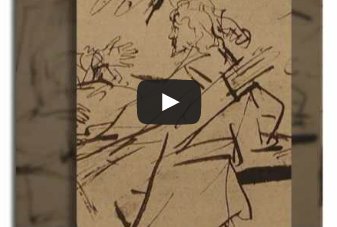To become a Rembrandt scholar you need to pass out top of a prestigious course in art history. They are the crème della crème; but they are gravely mistaken about Rembrandt and resist correction no matter what the evidence for revision. This article is designed to convince you they need to be replaced. They will not renew themselves.
They have in fact stood Rembrandt on his head. Reversing his significance of perhaps the world’s most perceptive observer. They seek to persuade us that he worked largely from imagination. I believe that I have demonstrated this to be a fundamental mistake, yet they will not budge. As a simple example see my “Isaac Refusing to Bless Esau” on YouTube. I expect you will agree with me that Rembrandt was at his best as an observer.
Esau and Isaac
This disagreement as to whether Rembrandt relied on observation or invention is a fundamental error, which invalidates large areas of recent scholarship. An error from which Rembrandt scholarship is suffering and has suffer since 1922 at when this important drawing was dismissed – important because it shows us Rembrandt’s strengths and weaknesses. Because I accept the weakness I can believe in over 2,000 drawings by Rembrandt but the scholars’ refusal leads them to accept only 500! His position as a culture hero has fallen proportionately in my life time.
I find it very easy to win the observation argument, so I well understand why the scholars refuse to debate the point in public. Choosing instead to undermine my examples in their private world of scholarly publications so they can continue with their folly undisturbed. I have described the scholarship of Rembrandt drawings as “an unmitigated disgrace” for the following reasons:-
1. My paradigm changing discovery of Rembrandt’s Use of Models and Mirrors in 1974 has been neglected. These findings were published in the Burlington under that title in Feb.1977 (two eminent art historians, Prof. Sir Ernst Gombrich and Dr J. Montagu were thanked for their help in presenting my findings in that article). A similar article was published in Rembrandthuiskroniek vol.1 1978. In both I believe I proved, beyond reasonable doubt, that Rembrandt used groups of live models for himself and his students to work from. This idea is anyway corroborated by contemporaries of Rembrandt; what was all that theatrical wardrobe for if not to produce his groups? (an extensive wardrobe and props is seen in the inventory of his belongings taken in 1656.)
2.Recent Rembrandt scholarship has neglected the historical record, indeed reversed the known facts.
3. Over a period of 90 years they have apparently unanimously accepted this reversal, neglecting an abundance of evidence that should have warned them off. They do this in order to maintain their mistaken ideas of Rembrandt’s development as a draughtsman and his relationship with the school production; they have substituted theoretical iconography where practical observation explains the school works better. These sins have suffocated the educational atmosphere of art history. The Rembrandt catastrophe could not have happen without unquestioning acceptance of the professor’s dictate.
4. The scholars refuse to discuss and continue with the destruction of Rembrandt in the face of overwhelming evidence of their folly – or worse.
5. As a sculptor of 60 years experience, I find their judgments often outrageous.
